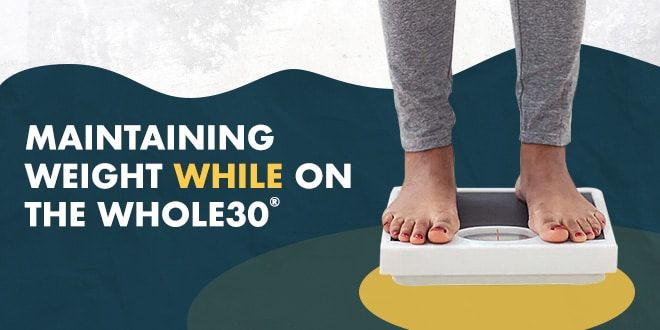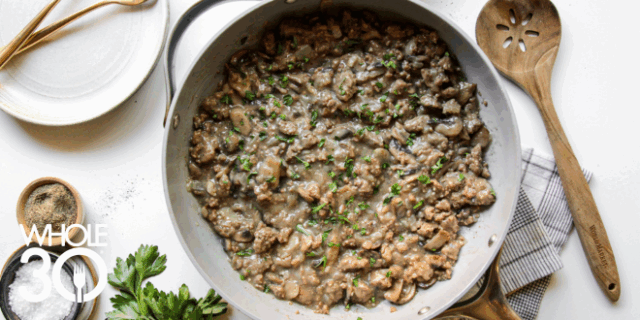The Whole30 isn’t designed to help people change their body composition or lose weight, and we ask people to take a much-deserved break from the scale and taking body measurements during their program. But what about those who purposefully want to maintain body weight and muscle mass on the Whole30? For highly active people, athletes (especially those doing high-intensity activity), and those with higher metabolic needs, it’s easy to maintain muscle mass if you’re conscientious about how you navigate the program. Today, we’ll talk about some obvious and not-so-obvious tips for those undertaking a Whole30 by-the-books and looking to maintain body weight and muscle mass in the process.
Food Factors
The first tip is obvious—eat more. You’d be surprised, however, at how many times Whole30 first-timers think they’re eating plenty, but are actually under-fed. Swapping out grains and legumes for vegetables and fruits can put you in a caloric deficit. You’ve got to make those calories up somewhere—and in the case of our general meal planning recommendations, that comes in the form of healthy fats and starchy vegetables. But if you’ve been conditioned to eat a low-fat diet, adding as much fat as you need to maintain a healthy body weight may not come naturally. From another angle, if you’re a little carb-phobic, you may be limiting potatoes, winter squashes, and fruit on purpose—and if you’re especially active with CrossFit, running, soccer, or other higher-intensity activities, you likely won’t perform your best on leafy greens and low-carb veggies alone. Finally, for those new to the Whole30, your satiety signals may take a week or two to self-regulate, leaving you feeling full after even smaller meals. Remember, protein and fat in their whole-food form are quite satiating, and if you’re used to filling up on food-with-no-brakes, you may not be used to that feeling of fullness. Be patient here, as this tends to regulate within just a few weeks.
- Action Item: Get your calories in. If those satiety signals are misfiring, you may feel like you’re eating too much, because you’re full all the time. Still, make sure you’re eating at least three meals a day, plus a post-workout meal if needed. And while we discourage people from grazing like antelope all day long, if you do find you’re hungry between meals, go ahead and have a snack—ideally including a decent amount of protein, fat, and carbohydrate. (Snacking on just an apple isn’t doing much for your cause.)
- Action Item: Prioritize protein. While eggs are nutrient-rich and an easy breakfast option, many folks find they hit their satiation point on just two or three. But eggs are light on protein compared to comparable amounts of red meat, chicken, or salmon. Try branching out into other kinds of meat and seafood for breakfast, because it’s important to eat enough of everything—fat, carbohydrate, and protein.
- Action Item: Eat more carbs. While we love leafy greens and other nutrient-dense vegetables, your priority needs to be both nutrient and calorie-density. Don’t fill up on bowls of salad and platefuls of broccoli, leaving less room in your belly for meat and fat. Prioritize carb-dense vegetables with each meal (like potatoes, winter squashes, beets, taro, yuca, and parsnips) and include some fruit with meals as well. This will serve your athletic or activity needs, and ensure you’re not burning through your own muscle mass for energy.
- Action Item: Eat more fat. Go back to our Meal Template as your starting point. The fat amounts outlined should be the minimum per meal on your Whole30, but you’ll likely want to up your amounts to the higher end of the spectrum, if not beyond.
- Action Item: Add smoothies if needed. We generally recommend against liquid food because it bypasses normal satiety signals, prompting people to feel less satisfied after their “meal” and potentially leading them to overconsume. In this case, however, you may want to purposefully add smoothies to your meals (or in between) to sneak in extra calories and protein. Here’s an article on the Plant-Based Whole30 that will help you build healthy, balanced smoothies. (Note, the protein powders mentioned here are also compatible with the Original Whole30 program.)
Lifestyle Factors
So we’ve covered the obvious food angle… but there is much more to this story than just eating more. Other lifestyle factors, like training, recovery, and stress, all play into your ability to maintain weight and muscle mass. Certain exercise protocols (especially those with lots of longer-duration, moderate to high-intensity activity) can whittle off body weight—often in the form of muscle mass—faster than you could eat it back on. This can be extra-challenging without the normal carb sources you’re used to fueling with, like rice, oats, and gels. Even if you are on a strength-focused program, if your recovery practices are inadequate, it will be much harder to maintain your gains. Lifting heavy five days a week doesn’t mean squat if you’re only sleeping five hours a night, not doing any recovery work, are under-eating, and are chronically stressed with work, school, family, or financial worries.
- Action Item: Rethink your training. Consider swapping out those long, hard training sessions for very short high-intensity metabolic conditioning and strength work for the duration of your Whole30… and make sure no matter what your training looks like, you’re eating enough to support those activities.
- Action Item: Prioritize recovery. Make sure your recovery efforts are adequate for the frequency, duration, and intensity of your training sessions. If you don’t have the time to properly recover, step down your training. Remember, you don’t get fitter when you train, you get fitter when you recover from that training. Prioritize sleep first, then add in walks, recovery practices like mobility or foam rolling, and other practices like acupuncture, meditation, or therapy.
Check Under the Hood
Finally, consider consulting a functional medicine practitioner and having them analyze factors like your stress hormones, thyroid function, and gut health. Factors like parasites, bacterial imbalances, environmental toxins, micronutrient deficiencies, and food sensitivities all influence your body’s ability to turn nutritious food into healthy body tissue. A stress response gone awry can dramatically tilt the balance of tissue breakdown and repair towards ongoing breakdown. Over time, this can erode your muscle mass. A good functional medicine practitioner will address lifestyle influences on your stress response, and give you some useful strategies to start to normalize the way your brain not only perceives stress, but also how your brain (and adrenal glands) respond to stress.
- Action Item: Consult a Professional. You can consult the Institute for Functional Medicine to find a practitioner in your area.
Live your Food Freedom
Finally, remember the purpose and intention of the Whole30: it’s a learning tool, designed to help you figure out how foods impact you, individually, and bring you to sustainable Food Freedom. If you get through your Whole30 reintroduction and determine that whey protein, rice, oats, and gluten-free pasta make your health efforts that much easier (and that you tolerate those foods well), add them back into your diet! The program is just a short-term experiment, not a forever way of eating. Use the tools we provide to figure out what works best for your goals, and your body.
















